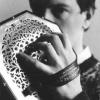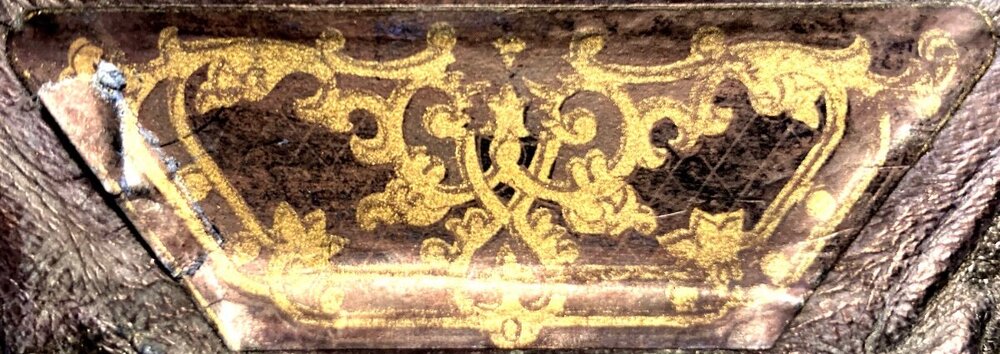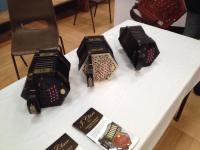-
Posts
704 -
Joined
-
Last visited
About Henrik Müller
- Birthday 02/08/1947
Contact Methods
-
AIM
none
-
MSN
none
-
Website URL
http://www.concertinamatters.se
-
ICQ
0
-
Yahoo
none
-
Skype
handstrapz
Profile Information
-
Gender
Male
-
Interests
Irish traditional music, concertina making/design/acoustics
-
Location
Skåne (Scania), Southern Sweden
Recent Profile Visitors
Henrik Müller's Achievements

Heavyweight Boxer (5/6)
-
Corey. S started following Henrik Müller
-
Interesting discussion, folks! You have missed something, Chris - I just don't know what it is 🤪, except that it could simply be an EC thing - I don't think Anglos have problems like having to throw the middle finger below, or (even) over the index finger. The fingers are more straight on, and the spacing is wider, too. Says the non-Anglo player... The background for it all started after I had played the little 18 button Stagi EC the first time in 2003? (Samantha Payn - remember?!), and was wondering: "What is it that makes this feel so good and the playing so different (= pleasant)? And after a few more tunes, I realised it was three things: 1) There was more button spacing (vertical 12.5 mm, horisontal 15.5 mm) 2) The buttons went all the way down, flush with the ends 3) The button had slightly bigger diameter 1) and 2) For me, the larger spacing and the "deep buttons", as I call them, led to the development of a better fingering and almost begged for a religiously strict "Never the same finger twice on the same button". What does that mean? Say you have a repeated middle "a". According to The Good Books, you press the "a" twice with your R1 (right index finger). Well... it works, but what if you want the attack on the second "a" a bit harsher, or snappier? As part of your interpretation of the tune? Same finger: beep, beep Now try this: hit the "a" with your R1 and WHAM! a second time, with your R2 (right middle finger). Two fingers: beep, Beep! Now that makes a difference to the attack, doesn't? "Yeah, and it makes me fingers hurt!" Yes - after a 2-3 hours (session) the fingertips start to feel a bit sore...unless, of course, you are playing an instrument with deep, or flush buttons. Unfortunately, this is only possible with a bespoke instrument, because the obvious, nice looking, non-invasive solution that Fred made, has the built-in problem that Geoff pointed out: the buttons stop prematurely = before the pad is fully lifted. It does the job, but it's up to the individual instrument what effect the resulting lift has. 3) The Stagi button diameter (5.5 mm) had a slight, pleasant feel. At the time of the "Stagi experience" I'd had very little experience with button diameters: My Wheatstones all had 3/16" (4.75 mm) semi-domed buttons and another, older Wheatstone (or Rock Chidley) had completely flat (apart from a slightly rounded edge) German silver-capped buttons. Terrible stuff! But again - I am sure there are styles of playing that goes fine with flat buttons. It was only after playing my build No 1 (diameter 5.7 mm Rotring pencil caps) and comparing it with my build No 3 (diameter 4.75 mm Suttner buttons - like Wheatstone, but with a fraaaaction sharper edge) that I came to a decision with respect to The Two Ds (diameter & dome). If I could choose freely, I would have: Diameter: 5.5-5.7 mm Dome: Ideally, the mix between a circle and a square = with no edge whatsoever. Funnily enough, the preference for such a dome came out of the increased freedom my fingers got with the wider spacing, hence a bigger chance to hit the edge of a neighbour 🤪 But all this is me (for 16 years), and as Geoff says - we are all different - P. S. - if you get a chance to try a modern instrument with deep/flush buttons (they are out there) , don't disqualify it after two minutes, give it a chance! After all, you'll be fully occupied trying to find the thumb strap and the pinkie rest 😎 /Henrik
-

Known bellows paper?
Henrik Müller replied to Henrik Müller's topic in Instrument Construction & Repair
Like wise, Jake - if not this year either, it'll three years without Consairtín 😳 -
Henrik Müller started following Known bellows paper?
-

Known bellows paper?
Henrik Müller replied to Henrik Müller's topic in Instrument Construction & Repair
Thanks, Jake, it has indeed - Happy New Year to ye (and all who reads this) Bellows depth = 1" and 5 folds- A bit of a mystery, the paper. I must admit that though I can accept "variations" on the original, I can't really buy that as an explanation to why it is coal black now. There is no trace a green anywhere, and I scraped through a paper (yes - very invasive - I am making new bellows) and it's black all the way through. Washing with leather dye I can accept if it leaves the gold pattern untouched (as well as the "grid with small dots" in the background). But if the leather dye ends up as fine, black powder, why is it only on the papers, not on the leather? Unless the leather reacts differently (than the paper does). And green? Why use green if the leather is black? Mystery, mystery... On the papers I have seen,all graphic objects are made as a fill and a stroke. Fill is either gold or green, and the stroke is black. Now, if the background is meant to be black (from the start), a black stroke doesn't make any sense, yes? In that case something else is called for - another graphic element, which there is: In this new and better photo, you'll notice that the gold objects all have a line that "follows" its curvature, creating a 3D effect. I have sometimes used this trick in simple graphics like icons (very limited area) to simulate shadows, with the "sun" coming from north-west (here, in this damaged object, it looks like the sun or light source comes from south-east. You can also see, much better, the "grid" pattern in the back ground. Anyway - I have just found similar papers (with different colours) with much clearer graphic objects, so I will update the vector version I have started. I'll be back 😉 /Henrik -
Bellows paper Is this paper recognised by anyone? It is on a Wheatstone from 1863 - Gilding The bellows are probably the original - and there is very little gold left in the gilding (seen below) /Henrik
-
Hi, all - If you find my web site too big a mouthful, I now have an article out on The Concertina Journal: https://www.concertinajournal.org/articles/no-thumb-straps-no-finger-rests-but-it-is-an-english-a-personal-journey/ It's a compressed overview of the last 12 years of building, experimenting and playing. My web site has been updated to match the article. /Henrik
-
Henrik Müller changed their profile photo
-

Remaking ends by hand
Henrik Müller replied to Rod Pearce's topic in Instrument Construction & Repair
Hi, all - What I find difficult is keeping the blade vertical, in two planes, that is. Any quality of saw can't solve that problem. I have a saw like SteveS's - wonderful tool, but still...The effect of failing to do that is, of course, the the sides of the fretwork aren't vertical, and the thicker the wood, the worse the probelm. Metal end? No problem. Maybe it's just impatience... /Henrik -

My web site is (finally) up to date
Henrik Müller replied to Henrik Müller's topic in Instrument Construction & Repair
Thanks, Tiposx - it dawned on me that a well-defined description of the main features of the design was in order. And obviously it was! Button spacing It’s not that the fewer buttons led to wider spacing - like “Oh, I need fewer buttons, so now I can have wider spacing!” Wider spacing was the goal in itself, the dimensions simply copied from the litle Stagi I felt so comfortable with. The fewer buttons came out of two things: A good number of #s and bs I would never need. The top 8-10 notes I wouldn’t need either - which was good, since I wouldn’t have been able to reach them, because of the increased vertical spacing Two things limit the number of top notes (1) When you can’t reach them, and (2) when the top levers become unrealisticly short. Button that travel down to the ends This feature had more positive impact on playing than I could have foreseen. Together with the wider button spacing it allows for more creative fingering. Straps I use the word “hand straps” to distinquish them from English concertina wrist straps. They sit across the hand at an angle. Just being picky ? /Henrik -

My web site is (finally) up to date
Henrik Müller posted a topic in Instrument Construction & Repair
Hi, All - I've been away from c.net for a long time and away from my own web site for longer... but that doesn't mean that nothing has happened! The site is now updated - the latest fun starts at this section ("Twelve years later (2018)"): http://concertinamatters.se/styled-25/index.html All the best, /Henrik -

Buttons With Delrin Core And Metal Caps
Henrik Müller replied to alex_holden's topic in Instrument Construction & Repair
Using the Rotring pen caps was a saved-by-opportunity thing - they ARE good, but veeery expensive. Much later - now, that is - I have changed my opinion about cap diameter. In the beginning I had fantasies about caps/buttons more than ¼ "/6.35 mm... Then I made #2 (inspite of great look-and-feel still a work in progress, when it comes to reeds) and used buttons from Jürgen Suttner. Ooh - very good, lovely feel. Then I made #3 - yes, I WILL update my web site ;-) (Wheatstone reeds, pan and bellows frame, with new bellows) with my own user interface = end box/action and used Suttner buttons again. A peculiarity (for many) of my user interface is the fact that the buttons go all the way down to the bushing. This time they stopped - because of a small misunderstanding with myself - 1 mm before. No good... hmmm, aha! I removed (my own) felt stoppers under the buttons since they were exactlt 1 mm. What a difference! ;-). Anyway, this instrument has been played a couple of 100 hours, and I am convinced: I want the small ones (Jürgens) - they are 4.8mm. In contrast, the oul Rotrings are 5.8. Two different worlds! It goes to show how different preferences are - /Henrik -
Very impressive, Alex, very neat! Has certainly kicked off some thinking here... /Henrik
-
The hand rest on the finished instrument was the outcome of playing around (literally) with physical additions to the little Stagi 18-key. The outcome was the realisation that I play at an angle with respect to the vertical center line. Thus, the hand rest was angled 10-15 degrees. The shape of the hand rest? I didn't know, so I left it sort-of-rounded for 10 years, annoying the pinkie finger hand joint on the right hand! Only this summer did I add a slope (sloping of down to the edge) - a copy of the hand rest on my second instrumernt (finished, though still in the making = new reeds (not frames) need to be made). But the rests are good ;-) This is not to be considered an experiment anymore - more than 3.700 hours of playing have proven its worth. This is also due to the "rearranged keyboard": horizontally spaced out buttons, which go all the way down. Heresy, heresy... Better get started on the bellows for the third instrument ;-) /Henrik
-

Black Bellows Papers
Henrik Müller replied to Don Taylor's topic in Instrument Construction & Repair
I've been having the same headache. I found this: http://www.buchbinderei-obermeier.de/einbandmaterial.html (No English) - scroll down to "Lederimitate" and "Scaphandre" - looks pretty good, I'd say. The only thing is that it seems to be a page where you go and decide the looks of the notebook you are about to order, not where you select papers to buy. And do they sell to "civilians"? Germans - any help here? /Henrik -
Hi, Steve - Let me throw in my two cents here: I have played EC since 1977, and with time - and more confidence in playing - I developed pains in my thumb joints. I am one of those players who holds the instrument with the outer tip of the thumb, since I otherwise have difficulties reaching low notes *). That doesn't make the situation better. So the more I attempted adding more dynamics to a tune, the more pain I had. Fast forward to SSI 2003, I think, when I stumbled upon a Stagi Miniature and realised that, in spite of missing low notes and a general low-quality instrument (sorry, Stagi owners, nothing personal), I could play more freely and better than on my 1909 48B, ME Wheatstone. As a result I ended up building an instrument, based on the some of the physical properties of the Stagi, but with greater range. These properties were: "Scaled-up" distance between buttons, more space horizontally The buttons go all the way down, don't stop half-way. Since the design of the new instrument was based on my fooling around with the Stagi, it also involved Anglo-like hand straps and hand rests - the latter being tilted a bit downwards, to facilitate a roughly 25° "fingering direction" as opposed to a classic "vertically up and down the rows". The thumb strap? Gone. The pinkie rest? Gone. Right, I am coming to it... soon... The instrument was ready in 2006 and I estimate that since then I have played approx. 3500 hours. Non-stop sessions (ITM) of 3-6 hours and not a pain in sight. What I didn't know was the design, especially the wider button spacing and the "all-the-way-down buttons" allowed - or led to - a new type of fingering (more room to do "illegal moves"). Out of curiosity I've tried the wrist straps on my wife's Æola - great. Yes! - that would do it - apart from the "so many buttons, so little space"-feeling, the confidence from having control with the whole arm instead of the thumbs is the same. So I would say: make, have one made, buy, borrow a set of wrist straps. Once they are on, focus on the feeling of having all the pull across the hands and the thumbs fully relaxed. Good luck! /Henrik *) Play "Farrell O'Gara" with the thumbs all the way in the straps. No fun.
-

Concertina Maker Jose Claro?
Henrik Müller replied to Daniel Hersh's topic in General Concertina Discussion
I heard about and met him for the first time in Ennis last week. Very impressed by his instruments - he makes both accordion-reeded and concertina reeded. Also a beatiful, small instrument (not at home, don't have his brochure here). /Henrik -

Here We Go Again...
Henrik Müller replied to Henrik Müller's topic in Instrument Construction & Repair
Thanks, Adrian - Yes, the crimping jig worked very smoothly. PM me if you have laser cut urges ;-). I was tempted to go to Germany, but I have a deadline ;-) and I'll meet Mary in Ennis, I am sure. /Henrik









